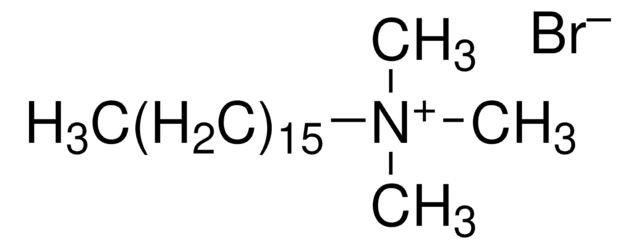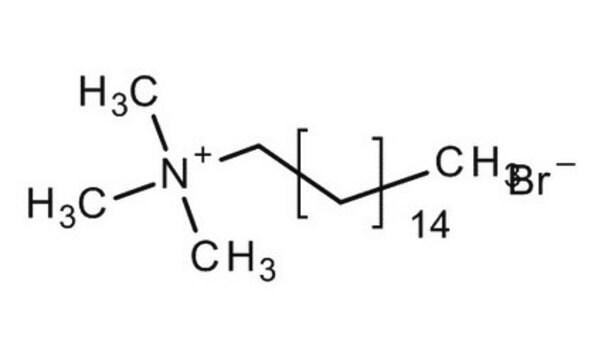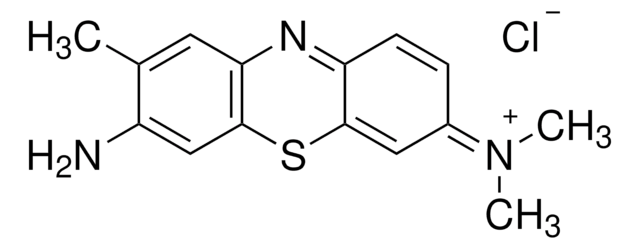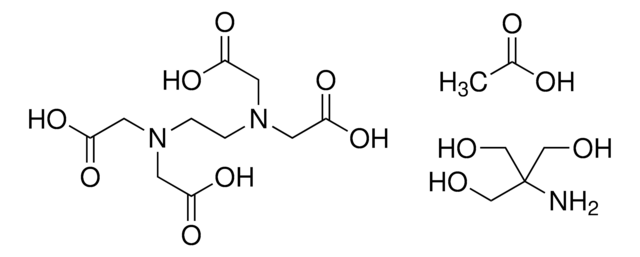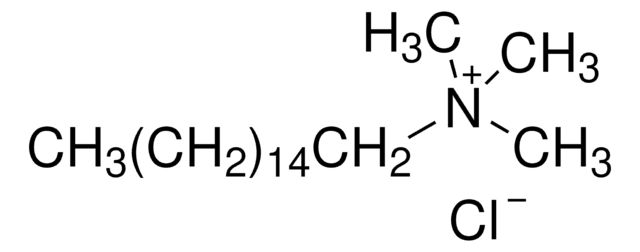52365
Bromure d'hexadécyltriméthylammonium
BioUltra, for molecular biology, ≥99.0% (AT)
Synonyme(s) :
Bromure de cétrimonium, Bromure de cétyltriméthylammonium, Bromure de palmityltriméthylammonium, CTAB
About This Item
Produits recommandés
Qualité
for molecular biology
Niveau de qualité
Description
cationic
Gamme de produits
BioUltra
Essai
≥99.0% (AT)
Forme
powder or crystals
Poids mol.
micellar avg mol wt 62,000
Nombre d'agrégation
170
Impuretés
DNases, none detected
RNases, none detected
insoluble matter, passes filter test
phosphatases, none detected
proteases, none detected
Résidus de calcination
≤0.2%
Perte
≤0.5% loss on drying
pH
5.0-7.0 (25 °C, 0.1 M in H2O)
CMC
0.92
1 mM (20-25°C)
Pf
248-251 °C (lit.)
Solubilité
H2O: 0.1 M at 40 °C, clear, colorless
Traces d'anions
sulfate (SO42-): ≤50 mg/kg
Traces de cations
Al: ≤5 mg/kg
Ba: ≤5 mg/kg
Bi: ≤5 mg/kg
Ca: ≤10 mg/kg
Cd: ≤5 mg/kg
Co: ≤5 mg/kg
Cr: ≤5 mg/kg
Cu: ≤5 mg/kg
Fe: ≤5 mg/kg
K: ≤50 mg/kg
Li: ≤5 mg/kg
Mg: ≤5 mg/kg
Mn: ≤5 mg/kg
Mo: ≤5 mg/kg
Na: ≤50 mg/kg
Ni: ≤5 mg/kg
Pb: ≤5 mg/kg
Sr: ≤5 mg/kg
Zn: ≤5 mg/kg
Chaîne SMILES
[Br-].CCCCCCCCCCCCCCCC[N+](C)(C)C
λ
0.1 M in H2O
Absorption UV
λ: 260 nm Amax: 0.06
λ: 280 nm Amax: 0.05
HLB
10
InChI
1S/C19H42N.BrH/c1-5-6-7-8-9-10-11-12-13-14-15-16-17-18-19-20(2,3)4;/h5-19H2,1-4H3;1H/q+1;/p-1
Clé InChI
LZZYPRNAOMGNLH-UHFFFAOYSA-M
Vous recherchez des produits similaires ? Visite Guide de comparaison des produits
Application
Mention d'avertissement
Danger
Mentions de danger
Conseils de prudence
Classification des risques
Acute Tox. 4 Oral - Aquatic Acute 1 - Aquatic Chronic 1 - Eye Dam. 1 - Skin Irrit. 2 - STOT RE 2 Oral - STOT SE 3
Organes cibles
Gastrointestinal tract, Respiratory system
Code de la classe de stockage
11 - Combustible Solids
Classe de danger pour l'eau (WGK)
WGK 3
Point d'éclair (°F)
471.2 °F - closed cup
Point d'éclair (°C)
244 °C - closed cup
Équipement de protection individuelle
dust mask type N95 (US), Eyeshields, Faceshields, Gloves
Faites votre choix parmi les versions les plus récentes :
Déjà en possession de ce produit ?
Retrouvez la documentation relative aux produits que vous avez récemment achetés dans la Bibliothèque de documents.
Les clients ont également consulté
Notre équipe de scientifiques dispose d'une expérience dans tous les secteurs de la recherche, notamment en sciences de la vie, science des matériaux, synthèse chimique, chromatographie, analyse et dans de nombreux autres domaines..
Contacter notre Service technique